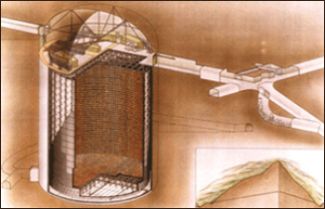T2K Experiment Detects New Neutrino Phenomenon

The T2K experiment was designed to measure a physical phenomenon known as neutrino oscillation. In this process a specific type of neutrino alters its nature in flight and transforms into another type of neutrino. The observation of this phenomenon contributes to the measure of mass of different types of neutrinos, as well as to the understanding of the relation between them and their nature per se. Today, T2K is possibly the most sensitive neutrino oscillation experiment existing in the world. It is made up of the Super-Kamiokande detector, located underground in the town of Kamioka, in the Gifu Prefecture of Japan, and of the accelerator complex Japan Proton Accelerator Research Complex (J-PARC), where muon neutrinos are produced in large quantities and directed to the Super-Kamiokande, which is 295 km away.
The discovery of this type of oscillation will have a strong impact on the future of this field and represents the first step towards solving one of the greatest mysteries of the Universe: the power of matter over antimatter. This is precisely why scientists all over the world have worked on developing an ambitious experimental programme devoted to observing this phenomenon. Over 500 researchers from 12 different countries are collaborating on the T2K experiment. Spain takes part in the project with researchers from the Institute of High Energy Physics (IFAE) in Barcelona and the Institute of Corpuscular Physics (IFIC) in Valencia In the past ten years these scientists have participated in the design, construction and operation of the experiment.
After analysing all data existing from the beginning of data collection in January 2010 to the earthquake which shook Japan in March 2011, 88 neutrino candidates have been detected in Super-Kamiokande and six have been identified as electron neutrinos. When electron neutrinos - as a result of oscillation - interact with matter, electrons are produced (as happens when muon neutrinos produce a heavier type of electron called a muon). Although electrons are observed, there are nevertheless other phenomena which can be taken for oscillations; known as background contamination. In the T2K experiment one or two contamination events were expected, in comparison to the six events observed. The probability that this excess be due to the appearance of electron neutrinos has been estimated at 99.3%, a very high rate which represents the first sign of the existence of this physical phenomenon.
Up until the tragic earthquake which occurred on 11 March 2011, T2K had accumulated only 2% of the neutrinos it expected to have during the life of the experiment. J-PARC is currently under repair and data collection will begin again before the end of the year.
With new data, scientists at T2K are waiting to confirm beyond doubts the appearance of electron neutrinos and combine this measure with the appearance of electron antineutrinos (antiparticles of electron neutrinos), with the aim of studying the phenomenon known as leptonic CP violation, which could be key in understanding the origin of asymmetry between matter and antimatter in the Universe. To reach this objective it is necessary to increase the intensity of the neutrino beam produced by the J-PARC accelerator and improve the sensitivity of the detectors. The appearance of electron neutrinos is the first step in the research of leptonic CP violations and observations taking place at T2K represents a very significant step in this direction.


